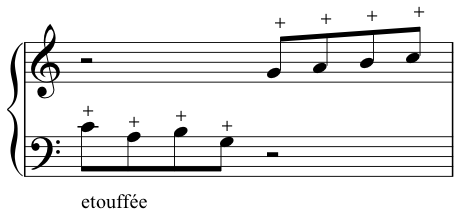Etouffée
Etouffée is French and means damped. The term is used to describe a damping technique used to damp one note after the other in order to get a sort of "portato" articulation in a line or a melody.
Production
The right and left hand produce the etouffée effect differently.
Left hand
The harpist keeps the palm of the hand open and plays the note with the thumb. The palm of the hand and the remaining fingers damp the note shortly after it is played.
Right hand
The right hand's second finger plays the note. In an upwards moving phrase or melody the knuckle of the second finger damps the note as soon as the second finger plays the next note. In a downwards moving phrase or melody the thumb damps the previous note. Unlike the left hand, the right hand can only play etouffée if the phrase in question is a continuous scale up or down.
Sound
Each string is muted shortly after it is played. The muting action is quite audible.
Notation
Etouffée is notated by writing the word etouffée above or below the notes in question and adding a plus sign.

Etouffée.
Range
The whole harp.
Additional Remarks
Playing etouffée requires precision and is a considerable action for the harpist. Therefore playing etouffée considerably slows the maximum speed of playing successive pitches.